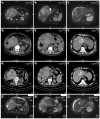Clostridium perfringens infection after transarterial chemoembolization for large hepatocellular carcinoma
- PMID: 25892893
- PMCID: PMC4394104
- DOI: 10.3748/wjg.v21.i14.4397
Clostridium perfringens infection after transarterial chemoembolization for large hepatocellular carcinoma
Abstract
We report an unusual case of Clostridium perfringens liver abscess formation after transcatheter arterial chemoembolization (TACE) for large hepatocellular carcinoma. Severe deterioration in liver and renal function accompanied with hemocytolysis was found on the 2(nd) day after TACE. Blood culture found Clostridium perfringens and abdominal computed tomography revealed a gas-containing abscess in the liver. Following antibiotics administration and support care, the infection was controlled and the liver and renal function turned normal. The 2(nd) TACE procedure was performed 1.5 mo later and no recurrent Clostridium perfringens infection was found.
Keywords: Clostridium perfringens; Hepatocellular carcinoma; Liver abscess; Major complication; Transcatheter arterial chemoembolization.
Figures

Similar articles
-
[Two cases of liver abscess caused by Clostridium perfringens after transcatheter arterial chemoembolization].Gan To Kagaku Ryoho. 2013 Nov;40(12):1795-7. Gan To Kagaku Ryoho. 2013. PMID: 24393925 Review. Japanese.
-
Liver abscess caused by Clostridium haemolyticum infection after transarterial chemoembolization for hepatocellular carcinoma: A case report.Medicine (Baltimore). 2018 May;97(19):e0688. doi: 10.1097/MD.0000000000010688. Medicine (Baltimore). 2018. PMID: 29742715 Free PMC article. Review.
-
[A case of a gas-forming liver abscess caused by Clostridium perfringens after transcatheter arterial chemoembolization].Nihon Shokakibyo Gakkai Zasshi. 2018;115(6):554-562. doi: 10.11405/nisshoshi.115.554. Nihon Shokakibyo Gakkai Zasshi. 2018. PMID: 29887591 Japanese.
-
Multimicrobial sepsis including Clostridium perfringens after chemoembolization of a single liver metastasis from common bile duct cancer.Digestion. 2000;62(2-3):208-12. doi: 10.1159/000007815. Digestion. 2000. PMID: 11025370
-
High Fever After Radiofrequency Ablation of Hepatocellular Carcinoma.Gastroenterology. 2018 Aug;155(2):e3-e4. doi: 10.1053/j.gastro.2017.12.037. Epub 2018 Feb 1. Gastroenterology. 2018. PMID: 29409827 No abstract available.
Cited by
-
Clostridium paraputrificum septicemia and liver abscess.World J Hepatol. 2018 Mar 27;10(3):388-395. doi: 10.4254/wjh.v10.i3.388. World J Hepatol. 2018. PMID: 29599902 Free PMC article.
-
Pyogenic liver abscess in non-liver cancer patients and liver cancer patients treated with TACE: Etiological characteristics, treatment, and outcome analysis.Kaohsiung J Med Sci. 2023 Jan;39(1):87-94. doi: 10.1002/kjm2.12613. Epub 2022 Nov 10. Kaohsiung J Med Sci. 2023. PMID: 36354204 Free PMC article.
-
A case report of fatal hepatic portal venous gas after transcatheter arterial chemoembolization in a patient with hepatocellular carcinoma.Transl Cancer Res. 2021 Dec;10(12):5437-5442. doi: 10.21037/tcr-21-1721. Transl Cancer Res. 2021. PMID: 35116389 Free PMC article.
-
A suspected case of Clostridium perfringens sepsis with intravascular hemolysis after transhepatic arterial chemoembolization: a case report.J Med Case Rep. 2019 Apr 27;13(1):125. doi: 10.1186/s13256-019-2023-x. J Med Case Rep. 2019. PMID: 31027514 Free PMC article.
-
Fatal Liver Infection Caused By Clostridium perfringens After Common Bile Duct Stenting Due To Pancreatic Cancer: A Case Report.Infect Drug Resist. 2019 Oct 24;12:3343-3347. doi: 10.2147/IDR.S219472. eCollection 2019. Infect Drug Resist. 2019. PMID: 31695453 Free PMC article.
References
-
- Oshima S, Takaishi K, Tani N, Hirano M, Ikeda K, Makari Y, Hoshi M, Doi T, Kobori Y, Kurokawa E, et al. [Two cases of liver abscess caused by Clostridium perfringens after transcatheter arterial chemoembolization] Gan To Kagaku Ryoho. 2013;40:1795–1797. - PubMed
-
- Maluccio M, Covey A. Recent progress in understanding, diagnosing, and treating hepatocellular carcinoma. CA Cancer J Clin. 2012;62:394–399. - PubMed
-
- Jemal A, Bray F, Center MM, Ferlay J, Ward E, Forman D. Global cancer statistics. CA Cancer J Clin. 2011;61:69–90. - PubMed
-
- Takayasu K. Transcatheter arterial chemoembolization for unresectable hepatocellular carcinoma: recent progression and perspective. Oncology. 2013;84 Suppl 1:28–33. - PubMed
-
- Llovet JM. Updated treatment approach to hepatocellular carcinoma. J Gastroenterol. 2005;40:225–235. - PubMed
Publication types
MeSH terms
Substances
LinkOut - more resources
Full Text Sources
Other Literature Sources
Medical
Miscellaneous

